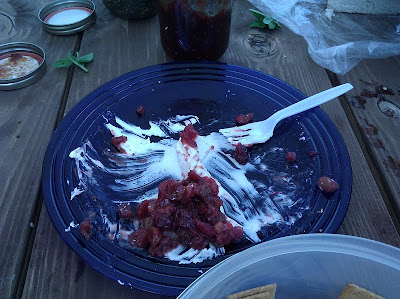One of the first recipes I remember clipping and saving was for Cranberry Apple Chutney. I don't know much about its origins, other than it likely ran in the early 1980s in the food section of The Indianapolis Star, where I was hired as a reporter after college. It has been my must-have Thanksgiving side ever since -- except for the bleak years when the recipe went missing.
 Those were dark, pre-internet days. I begged for copies from friends with whom I enthusiastically shared the recipe and tried several variations -- one boasting the endorsement of the White House kitchen. Nothing was quite right. Even my mother-in-law, who politely ate an annual dab even though it's not her thing, was heartbroken on my behalf.
Those were dark, pre-internet days. I begged for copies from friends with whom I enthusiastically shared the recipe and tried several variations -- one boasting the endorsement of the White House kitchen. Nothing was quite right. Even my mother-in-law, who politely ate an annual dab even though it's not her thing, was heartbroken on my behalf.Last year, however, when my husband declared that it was time to clear the attic of long-ignored boxes and install additional insulation, I experienced one of those moments of cosmic bliss where I was reunited with this now yellowed bit of newsprint. I made a batch right away, and several since. I have even enshrined the recipe in a frame that sits in a place of distinction in my kitchen.
Other that that one spontaneous batch, this remains a creation I needlless indentify expressly with Thanksgiving. Its tangy sweetness would be just as delicious slathered on a turkey or grilled cheese sandwich today, or in the middle of summer. And, preserved in small jars, it could be the enjoyed and emptied instead of spoiling amid the forgotten excess of post-holiday leftovers.
I made a triple batch (two full bags of fresh cranberries) for canning purposes, making just a few amendments to the original: I skipped the cloves, because I despise them, and while I've always used Granny Smith apples in the past I used honeycrisps because they are awesome. To extend safe shelf life, I also added a half-cup of cider vinegar and 2 cups of white sugar, neither of which resulted in a significant flavor variation.
When done, the cranberries should be mostly popped, or easily crush with light pressure from a spoon. The texture will be similar to jam or conserve. The mix will appear a bit wet when hot but, trust me, will set up nicely when cooled.
Process in prepared jars for about 10 minutes in a boiling water bath. Remove to heatproof surface and leave undisturbed until fully cooled. Be sure to bring some if you are traveling for Thanksgiving -- you never what sort of suspect cranberry concoction you'll find on even the most elegant table -- but don't wait until then to enjoy. I brought a jar to a canning workshop this weekend and spilled it over a block of cream cheese. Serve with crackers and be sure to grab a bite for yourself before it's gone.




















